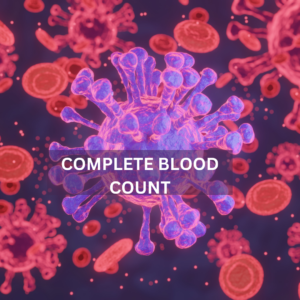
What is a (CBC) complete blood count?
- A CBC or complete blood count, is a blood test that measures various characteristics and parts of blood, including:
- Red blood cells carry oxygen from the lungs to the rest of the body.
- White blood cells that fight infections and other diseases. There’re five main types of white blood cells. The total number of white blood cells in the blood is measured by CBC test. Another test called differential measurement complete blood count measures the amount of each type of white blood cell.
- Platelets, that help the blood to clot, stopping bleeding.
- Hemoglobin, a protein contained in your red blood cells that carry oxygen from the lungs to your body parts.
- Hematocrit, a measure of the amount of blood made up of red blood cells.
- MCV (Mean corpuscular volume), a measure of the average red blood cells size.
Other names for CBC (complete blood count): full blood count, CBC, blood cell count.
In this complimentary complete blood count test guide, I will expose you to how CBC test is carried out at Big Man Lab. You will understand the importance, how to prepare, risks associated and what results mean. CBC blood test is often used with other blood test to provide health diagnosis.
Why is complete blood count done?
A full blood count is a common blood test for several reasons:
- To check your general health. A complete blood count may be part of your doctor's visit to check your general health and detect conditions such as leukemia or anemia.
- To diagnose medical condition. CBC test can help identify the cause of symptoms such as fever, fatigue, and weakness. Complete blood count can also help find the cause of pain and swelling, bleeding, or bruising.
- To review medical conditions. A full blood count can help monitor conditions that affect you blood cell counts.
- To review medical care. A complete blood count may be used to monitor treatment with medications that affect radiation and blood cell counts.
Risk associated with complete blood count
The risks of taking a blood sample are very low. The size of veins and arteries varies from one side of the body to the other and from person to person. Some people may find it more difficult than others to have blood drawn.
Other CBC test associated risks may include:
- Heavy bleeding
- Dizziness or fainting
- Hematoma (accumulation of blood under the skin)
- Minimal risk of skin damage (Infection)
When is complete blood count done?

You will need a complete blood count test if you have the following symptoms:
- Irritation and swelling (Inflammation) in any part of the body.
- Joint pains.
- Problems with blood pressure or heart rhythm.
- Bleeding or bruising.
- Weakness, dizziness or fatigue.
- Vomiting, nausea and fever.
What is complete blood count test look for?
The CBC performs numerous tests to measure and examine red blood cells, platelets, and white blood cells. RBCs transport oxygen throughout the body. Your immune system consist of white blood cells. They help fight your body infections. Platelets help in blood clotting.
The full blood count measures, evaluates, counts and examines many aspects of the blood:
- The complete blood count without differential measurement counts the total number of WBCs.
- Complete blood count with differential. You blood consist of five types of white blood cells. Differentiation refers to how many of each type of white blood cells are in your blood.
- A protein in RBCs that carries oxygen called hemoglobin is measured using a hemoglobin test.
- The concentration of RBC in blood is referred to as Hematocrit.
Measurement of red blood cells

Red blood cells, also called erythrocytes, transport oxygen from the lungs to the body's organs and tissues. The complete blood count test includes several basic red blood cell measurements:
- The total number of RBC’s in your blood sample is determined by a red blood cell count.
- The amount of oxygen-carrying proteins present in erythrocytes is measured using a Hemoglobin count.
- The proportion of total blood volume made up of RBCs is referred to as Hematocrit.
Complete blood count also provides details about the physical features of RBCs. This is called red blood cell indices, of which there are many types:
- MCV (Mean cell volume) is a measure of the erythrocytes average size.
- MCH (Mean corpuscular hemoglobin) is the average hemoglobin amount in an erythrocyte.
- MCHC (The mean cell hemoglobin concentration) is a calculated measure of the hemoglobin concentration in erythrocytes.
- RDW (Red blood corpuscular distribution width) is a measure of the variation in red blood cell size.
A complete blood count may include a reticulocyte count, the total number of red blood cells recently released into the blood sample. It can equally be measured in percentage.
White blood cell measurement
Leukocytes or also called white blood cells are an essential part of your body's immune system.
A standard complete blood count includes measuring the white blood cell count, which is the total number of white blood cells in a blood sample.
A common variant of the complete blood count is the CBC with differential. White blood cell differential is a breakdown of the number of each of the five different types of white blood cells:
Eosinophils: Eosinophils are leukocytes that are activated in response to hypersensitivity reactions like allergies and some types of infections.
Basophils: Basophils participate in the early diagnosis of infections, allergic reactions and wound healing.
Neutrophils: Neutrophils constitute the largest percentage of leukocytes and are produced by the bone marrow to combat various inflammatory and infectious diseases.
Lymphocytes: Lymphocytes, such as T cells and B cells, are primarily found in the lymphatic system and fight against bacteria and other blood pathogens.
Monocytes: They work together with neutrophils to fight infections and other diseases by eliminating dead or damaged cells.
Initial blood tests may include a differential complete blood count, or these blood tests may be performed after an abnormal initial standard complete blood count. Abnormal levels of certain white blood cells that could indicate an underlying health problem can be identified through differentiated white blood cells count. This is because each type of white blood cell has a different function.
Thrombocytes (platelet) measurement
Thrombocytes, also called platelets (PLT), are systemic cell fragments that circulate in your blood and play an important role in blood clotting. When bleeding begins after an injury occurs, thrombocytes helps stop the bleeding by adhering to the injury site and clotting to form a temporary platelet plug.
A standard component of a complete blood count is the platelet count, which is the amount of thrombocyte in your blood sample.
In certain cases, your doctor may ask the Big Man Lab to equally measure the MPV (mean PLT volume), which determines the average thrombocyte size.
Complete blood count tells your healthcare provider:
- The number of new blood cells your body produces.
- How many red blood cells (erythrocytes or RBC), white blood cells (leukocytes or WBC) and thrombocyte (platelets).
- Shape and size of blood cells.
What is complete blood count used for?
A CBC test is a common blood test that is often part of a routine lab test at Big Man Lab. A complete blood count can help identify various disorders, such as blood cancer, anemia, infections, and immune system diseases.
Why do I need CBC test?
Your doctor may have ordered a complete blood test as part of the exam or to monitor your general health. This test can equally be used to:
- Review changes in existing blood diseases.
- Helps diagnose immune system disorders, infections, blood disorders or other medical conditions.
How do you prepare for CBC test?
You can eat and drink normally before the test, if your blood sample is tested only for a complete blood count. You may need to fast for some time before the test if the blood sample will also be used for another test. Ask your doctor what you need to do.
What can you expect during a CBC test?
For a full blood count, a member of the Big Man Lab team draws a blood sample by inserting a needle into a vein in the arm, usually in the crook of the elbow. The blood sample is sent to the Big Man laboratory. You will be able to immediately return to your normal activities after the test.
Normal complete blood count test results
Below are the expected CBC test results for adults. Blood is measured in grams per deciliter (grams/dL) or cells per liter (cells/L).
RBC count
- Males: 4.35 to 5.65 trillion cells/L
- Women: 3.92 to 5.13 trillion cells/L
Hemoglobin
- Men: 132 to 166 grams/l (From 13.2 to 16.6 grams/dl)
- Women: 116 to 150 grams/l (From 11.6 to 15 grams/dL)
Hematocrit
- Men: from 38.3 to 48.6 percent.
- Women: 35.5 to 44.9 percent.
WBC count
- From 3.4 to 9.6 billion cells/L
Thrombocyte count
- Men: from 135 to 317 billion/l
- Women: from 157 to 371 billion/l
Is CBC not a definitive test?
Generally, a CBC test, also called a complete blood count test, does not provide all the answers to a diagnosis. Test results outside the normal range may require follow-up evaluation. Your doctor may need to look at the results of other blood tests in addition to your complete blood count test results.
For example, to someone who is healthy and has no symptoms of illness, complete blood count test results that are slightly outside the normal range may not be alarming. Further testing may not be necessary. However, blood test results that are outside the expected range for someone undergoing cancer treatment, may indicate that treatment needs to be changed.
In some cases, if your CBC test results are much above or below the expected range, your doctor may ask you to see a hematologist (doctor who treats blood disorders).
What do abnormal CBC test results mean?

Elevated levels of red blood cells, hematocrit, or hemoglobin may be due to:
- Lack of sufficient fluids and water. For example through diuretics to treat high blood pressure, excessive sweating, or severe diarrhea.
- Polycythemia vera
- Smoking
- Testosterone use
- Kidney disorders with high production of erythropoietin.
- Low blood oxygen levels over a long period of time, usually due to lung or heart disease, living at high altitude or chronic exposure to carbon monoxide.
Low levels of red blood cells, hematocrit, or hemoglobin are a sign of anemia, which can be caused by:
- Lack of iron
- Leukemia
- Long-term hepatitis infections.
- Poor nutrition and poor diet cause folic acid, deficiencies of iron, vitamin B6 or vitamin B12.
- Multiple myeloma
- Loss of blood (sudden or due to problems such as heavy periods of menstruation over a long period of time)
- Bone marrow failure (such as due to tumors, infections, or radiation)
- Breakdown of red blood cells (hemolysis)
- Tumor and cancer treatment.
- Some chronic diseases (such as chronic rheumatoid arthritis, ulcerative colitis, or kidney disease)
Leukopenia refers to lower than normal white blood cell count. A decrease in the number of leukocytes may be due to the following factors:
- Spleen or liver disease
- The spleen is enlarged.
- Viral infections such as AIDS or mononucleosis
- Medicines
- Liver damage or alcohol abuse.
- Systemic lupus erythematosus (autoimmune diseases)
- Bone marrow failure (for example, due to fibrosis, tumor, infection, or radiation)
- Chemotherapy drugs used for cancer treatment.
A high number of white blood cells is referred to as leukocytosis. This may be due to the following things:
- Leukemia
- Severe physical or emotional stress
- Tissue damage (for example, heart attack or due to burns)
- Some medications, such as corticosteroids.
- Infection
- Diseases such as allergies, rheumatoid arthritis or lupus.
A high thrombocyte count may be caused by:
- Lack of iron
- Bone marrow failure
- Bleeding
- Diseases such as blood diseases or cancer.
A low thrombocyte count can be caused by:
- The spleen is enlarged.
- Bone marrow problems (for example, due to fibrosis, tumor, infection, or radiation)
- Cancer medicines used in chemotherapy.
- Diseases that destroy blood platelets.
- During pregnancy
Big Man Lab Note: Doctors use complete blood counts (CBC) to treat diseases and help you stay in good health. Using a blood sample, a complete blood count can help detect hundreds of infections, conditions, and disorders. To ensure that treatment can begin as quickly as possible, a complete blood count can be used in early disease detection, sometimes even before symptoms appear. CBC test is an important tool for maintaining an excellent general health.







